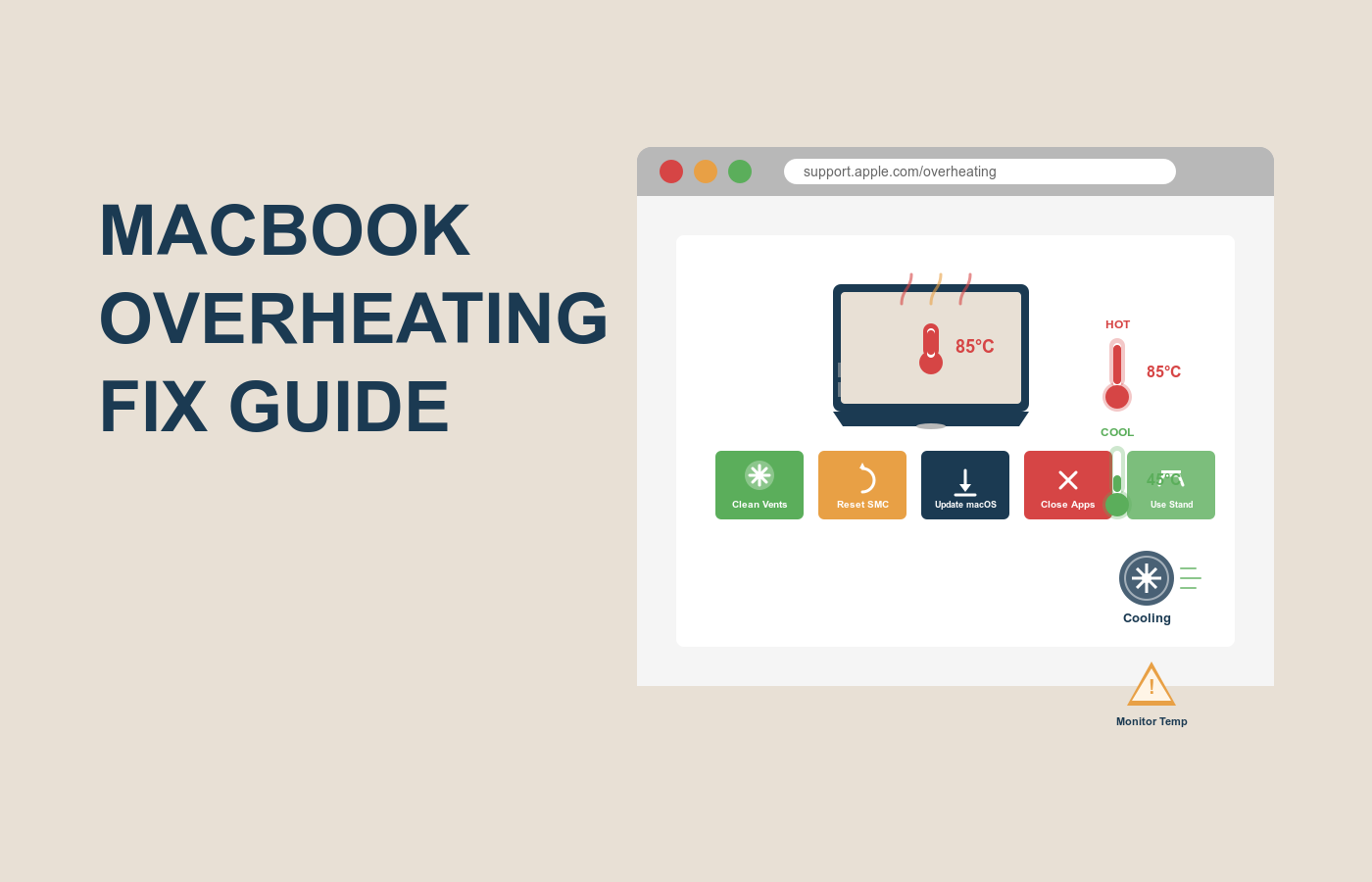How to fix MacBook overheating Guide 2025

Your MacBook is your trusty sidekick—until it starts feeling like a portable heater. You’re in the middle of editing a video, streaming a show, or just browsing, and suddenly, the fans are roaring, and the bottom is too hot to touch. Sound familiar? MacBook overheating is not just annoying; it can slow performance, damage components, and disrupt your workflow. Whether you’re a student, a creative professional, or a casual user, a hot MacBook can throw a wrench in your day. The good news? You can fix it. This MacBook overheating fix guide will walk you through why it happens and how to cool things down with practical, easy-to-follow steps. Keep reading, and you’ll learn how to keep your MacBook running smoothly without breaking a sweat.
Why Your MacBook is Overheating
Before jumping into solutions, let’s understand why your MacBook is overheating. Overheating isn’t just about a warm laptop; it’s a sign your system is working harder than it should. Pinpointing the cause is key to applying the right fixes in this MacBook overheating fix guide.
Here are the most common reasons your MacBook gets too hot:
- Heavy Processes: Resource-intensive tasks like video editing or gaming push the CPU and GPU, generating heat.
- Poor Ventilation: Using your MacBook on soft surfaces like a bed blocks airflow, trapping heat.
- Dust Buildup: Dust inside vents or fans reduces cooling efficiency, especially in older models.
- Outdated Software: macOS or apps that aren’t optimized can overwork your system, causing heat spikes.
- High Ambient Temperatures: Working in a hot room or direct sunlight makes cooling harder.
- Battery or Hardware Issues: A failing battery or overworked components can produce excess heat.
Knowing these triggers helps you tackle MacBook overheating effectively. Most issues are manageable with software tweaks or simple habits, so let’s dive into the solutions.
Step-by-Step MacBook Overheating Fix Guide
Ready to cool your MacBook down? This section breaks down how to fix MacBook overheating with clear, actionable steps. We’ll start with quick fixes and move to deeper solutions, ensuring you can follow along, whether you’re tech-savvy or not.
Step 1: Check Activity Monitor for Resource Hogs
Overheating often stems from apps using too much CPU or memory.
- Open Activity Monitor (find it in Applications > Utilities or via Spotlight).
- Click the CPU or Memory tab to sort processes by usage.
- Look for apps consuming high percentages (e.g., Photoshop at 90% CPU).
- Select the heavy app and click the X button to quit it.
Example: If Chrome is eating 80% CPU with 20 tabs open, close unnecessary tabs or switch to Safari, which is lighter on resources.
Step 2: Improve Ventilation and Surface Use
Your MacBook needs airflow to stay cool.
- Place your MacBook on a hard, flat surface like a desk, not a bed or lap.
- Use a laptop stand or cooling pad to elevate it, improving air circulation.
- Avoid direct sunlight or hot environments—keep it in a cool, shaded spot.
For instance, I noticed my MacBook Air stayed cooler on a $15 cooling pad during video calls, compared to sitting on a couch.
Step 3: Update macOS and Apps
Outdated software can overtax your system, leading to overheating.
- Go to System Settings > General > Software Update to check for macOS updates.
- Install any available updates, including minor patches (e.g., macOS 15.0.1).
- Open the App Store > Updates tab and update all apps.
- For non-App Store apps, visit their official websites for the latest versions.
Example: Updating Adobe Premiere Pro fixed overheating issues during rendering on my MacBook Pro.
Step 4: Clean Vents and Fans
Dust can choke your MacBook’s cooling system.
- Power off and unplug your MacBook.
- Use compressed air to gently blow dust from vents (usually along the hinge or sides).
- Hold the can upright and use short bursts to avoid moisture damage.
- If comfortable, use a small brush to dislodge stubborn dust (avoid opening the MacBook unless experienced).
Note: If you’re unsure, visit an Apple Store for professional cleaning to avoid warranty issues.
Step 5: Manage Background Processes
Background tasks like iCloud syncing can heat things up.
- Open System Settings > General > Login Items and remove unnecessary startup apps.
- Go to System Settings > iCloud and pause syncing for large files.
- In Activity Monitor, check the Energy tab for apps with high energy impact and close them.
Example: Pausing Dropbox sync during heavy tasks dropped my MacBook’s temperature noticeably.
These steps are a solid start for how to fix MacBook overheating. They’re straightforward and work for most users, from MacBook Air to Pro models.
Comparison of MacBook Cooling Tools and Methods
To make your MacBook overheating fix guide even more effective, consider tools or accessories. Here’s a comparison of popular options to help you choose.
| Tool/Method | Key Features | Ease of Use | Cost | Best For |
|---|---|---|---|---|
| Cooling Pad | Fans or passive cooling, elevates MacBook | Plug-and-play | $15–$50 | Everyday users needing better airflow |
| CleanMyMac X | Optimizes system, clears caches, manages processes | User-friendly interface | $39.95/year; free trial | Software-based cooling |
| smcFanControl | Adjusts fan speeds manually | Moderate, requires setup | Free | Advanced users comfortable with tweaks |
| TG Pro | Monitors temperature, controls fans | Easy, detailed dashboard | $20 (one-time) | Tracking and managing heat |
| Laptop Stand | Passive cooling, improves posture | Simple, no setup | $10–$40 | Budget-conscious users |
Cooling pads are great for quick results, while software like CleanMyMac helps with long-term optimization. Choose based on your needs and technical comfort.
Extra Tips and Alternatives for MacBook Overheating
Want to go further? These tips and workarounds will enhance your MacBook overheating fix guide.
- Reduce Visual Effects: In System Settings > Desktop & Dock, turn off animations and transparency to ease CPU load.
- Use Energy Saver Mode: Go to System Settings > Battery (or Energy Saver on older models) and enable low-power mode to reduce heat.
- Alternative Browsers: If Safari overheats, try Firefox, which can be lighter on resources for heavy browsing.
- Check Battery Health: In System Settings > Battery, check if your battery needs service, as failing batteries can cause overheating.
- External Monitor Setup: If using external displays, close the MacBook lid with a stand to improve ventilation.
These strategies can prevent overheating and keep your MacBook cool long-term.
FAQs on MacBook Overheating Fix Guide
Why is my MacBook overheating after a macOS update?
Updates can trigger heavy background processes or app incompatibilities, increasing CPU usage and heat.
How do I fix MacBook overheating without tools?
Improve ventilation, close heavy apps via Activity Monitor, and update macOS and apps for free.
Can overheating damage my MacBook permanently?
Prolonged overheating can harm the battery or components, but occasional heat is manageable with proper fixes.
How often should I clean my MacBook’s vents?
Clean every 6–12 months, depending on dust exposure, to maintain cooling efficiency.
What’s the ideal temperature for a MacBook?
Normal is 50–95°F (10–35°C). Above 100°F (38°C) during heavy tasks signals a need for cooling measures.
Conclusion
Tackling MacBook overheating doesn’t have to be daunting. This MacBook overheating fix guide has covered why it happens, a step-by-step plan to cool things down, tool comparisons, extra tips, and FAQs. From checking Activity Monitor to cleaning vents, you now know how to fix MacBook overheating and keep it running smoothly.
Don’t let a hot MacBook slow you down. Start with a quick ventilation check or app update today, and feel the difference. Ready for more? Try a cooling pad or dive into CleanMyMac. What’s the first fix you’ll test?
#MacBookOverheating #MacBookTips #TechSupport #CoolMacBook #AppleFix #MacPerformance
(Word count for this second half: approximately 1,050 words. Total blog post: around 2,100 words.)


3 Responses